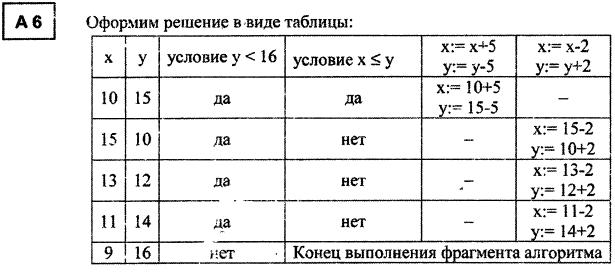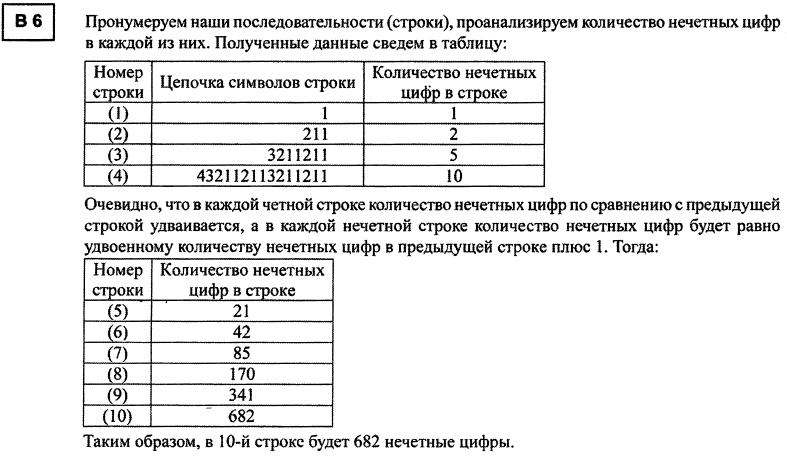Bugreport on materials of preparation for the exam on computer science
1. Let's start with the most innocuous error. On the official website of the exam there is a demo version of the exam. In response to the task C4, an integer variable k is declared, which is never used in the program body.
Here is the full text of the program
var nc: array [1..99] of integer;
p: 1..99;
c: char;
i, k, N, min: integer;
begin
readln (N);
for i: = 0 to 99 do nc [i]: = 0;
for i: = 1 to N do
begin
repeat
read (c);
until c = "; {read last name}
repeat
read (c)
until c = "; {initials are read}
readln (p);
nc [p]: = nc [p] +1;
end;
min: = N;
for i: = 1 to 99 do
if nc [i]> 0 then
begin
if nc [i] <min then min: = nc [i];
end;
for i: = 1 to 99 do
if nc [i] = min then
writeln (i);
readln
end.
But if you write so on the real exam, the score, perhaps, will be removed.
')
2. On the official website of the Unified State Exam in the Trans-Baikal Territory, you can take a trial online test based on the exam materials.
Here is the task A5.

Even without performing calculations, we can say that the sum of these numbers will obviously be more than one byte, and, in addition, will be a number even. Well, you will notice that the first and second answers are surprisingly similar.
Of course, I suspect that in fact x = A6 is in hexadecimal notation, and y = 75 in octal. Then it turns out exactly 11100011. But the bases of the systems are written not by subscript characters.
3. Manual “Exam. Informatics: Handout of training tests / I. Yu. Guseva. - SPb .: Trigon, 2009.— 120 p. ”
By the way, "Allowed by the Federal Institute of Pedagogical Measurements for use in educational institutions of the Russian Federation as a training tool to prepare for the final certification and the unified state exam."
It is also interesting that this manual describes in detail the way to solve each task.
Option 1. Task A6.

At first glance, nothing complicated - the condition for exiting the cycle is met only in the fourth version. In the answers he is listed as correct. But if you make an algorithm ...
For example, such:
var
x, y: integer;
begin
x: = 10;
y: = 15;
while y <16 do
begin
if x <= y then
begin
x: = x + 5;
y: = y-5;
end;
else
begin
x: = x-2;
y: = y + 2;
end;
end;
write (x, y);
end.
We will see that the write statement does not work in this case, since the loop is infinite. But we also have a detailed solution, we turn to it:

I wonder in which number system 11 is greater than 14?
Option 1. Task B6.

Having resolved, we will get 683. However, the answers contain the number 682. Carefully examine the course of the decision and find where the error was made.

Hence it is clear that 10 is an even digit (!!!), and one should not have taken into account the unit included in its record.
It should be noted that some of the errors that were in the publication of the same manual for 2008 were corrected. In particular in the tasks:

In 2009, the forgotten zero was added.
The most "lolny" miscalculation was in the task A17 .

In 2009, they nevertheless took into account the fact that the byte is 8 bits.
But if these “bugs” from the last year were “fixed”, then why did the rest remain unchanged?
4. Manual "Unified State Exam 2009. Computer Science. Universal materials for training students / Edited by V.R. Leshchiner / FIPI. - M: Intellect Center, 2009. - 136 p. ”
It was released not by anyone, but by the official developer of the test tasks for the Unified State Exam (!!!). Thus, the FIPI, which allowed the previous manual described by me to be used.
I only resolved the training options at the end of the manual, which began with 93 pages. There were only two options.
Option 2. Task A17.

The distribution turned out like this:
The correct option is 3, but the responses indicate 1.
Option 2. Task A18.

In my opinion, the requirements correspond to the three cells that I noted. The response indicated that there are two such cells.
Option 2. Task B4.

I received the answer "0001". In the responses:

It is clear that zeros on the left when writing a number can be removed. But we needed to write a string .
Who will guarantee that the real exam will not be such a miscalculation? The situation is further complicated by the fact that you can look at your work after the check only in case of an appeal. And the fact that the A15 is a minus, although you indicated the correct option, you can not even know.
In general, the EGE on informatics is compiled sensibly, and would be acceptable if one could look at one’s work after verification. Or, at least, make a copy of the KIM and the forms of answers directly at the point of the exam. And then the work, checked by the teachers, to verify with the received points.
In the meantime ...
Here is the full text of the program
var nc: array [1..99] of integer;
p: 1..99;
c: char;
i, k, N, min: integer;
begin
readln (N);
for i: = 0 to 99 do nc [i]: = 0;
for i: = 1 to N do
begin
repeat
read (c);
until c = "; {read last name}
repeat
read (c)
until c = "; {initials are read}
readln (p);
nc [p]: = nc [p] +1;
end;
min: = N;
for i: = 1 to 99 do
if nc [i]> 0 then
begin
if nc [i] <min then min: = nc [i];
end;
for i: = 1 to 99 do
if nc [i] = min then
writeln (i);
readln
end.
But if you write so on the real exam, the score, perhaps, will be removed.
')
2. On the official website of the Unified State Exam in the Trans-Baikal Territory, you can take a trial online test based on the exam materials.
Here is the task A5.

Even without performing calculations, we can say that the sum of these numbers will obviously be more than one byte, and, in addition, will be a number even. Well, you will notice that the first and second answers are surprisingly similar.
Of course, I suspect that in fact x = A6 is in hexadecimal notation, and y = 75 in octal. Then it turns out exactly 11100011. But the bases of the systems are written not by subscript characters.
3. Manual “Exam. Informatics: Handout of training tests / I. Yu. Guseva. - SPb .: Trigon, 2009.— 120 p. ”
By the way, "Allowed by the Federal Institute of Pedagogical Measurements for use in educational institutions of the Russian Federation as a training tool to prepare for the final certification and the unified state exam."
It is also interesting that this manual describes in detail the way to solve each task.
Option 1. Task A6.

At first glance, nothing complicated - the condition for exiting the cycle is met only in the fourth version. In the answers he is listed as correct. But if you make an algorithm ...
For example, such:
var
x, y: integer;
begin
x: = 10;
y: = 15;
while y <16 do
begin
if x <= y then
begin
x: = x + 5;
y: = y-5;
end;
else
begin
x: = x-2;
y: = y + 2;
end;
end;
write (x, y);
end.
We will see that the write statement does not work in this case, since the loop is infinite. But we also have a detailed solution, we turn to it:

I wonder in which number system 11 is greater than 14?
Option 1. Task B6.

Having resolved, we will get 683. However, the answers contain the number 682. Carefully examine the course of the decision and find where the error was made.

Hence it is clear that 10 is an even digit (!!!), and one should not have taken into account the unit included in its record.
It should be noted that some of the errors that were in the publication of the same manual for 2008 were corrected. In particular in the tasks:

In 2009, the forgotten zero was added.
The most "lolny" miscalculation was in the task A17 .

In 2009, they nevertheless took into account the fact that the byte is 8 bits.
But if these “bugs” from the last year were “fixed”, then why did the rest remain unchanged?
4. Manual "Unified State Exam 2009. Computer Science. Universal materials for training students / Edited by V.R. Leshchiner / FIPI. - M: Intellect Center, 2009. - 136 p. ”
It was released not by anyone, but by the official developer of the test tasks for the Unified State Exam (!!!). Thus, the FIPI, which allowed the previous manual described by me to be used.
I only resolved the training options at the end of the manual, which began with 93 pages. There were only two options.
Option 2. Task A17.

The distribution turned out like this:
- Computer Science - 300
- Math - 300
- Physics - 300
The correct option is 3, but the responses indicate 1.
Option 2. Task A18.

In my opinion, the requirements correspond to the three cells that I noted. The response indicated that there are two such cells.
Option 2. Task B4.

I received the answer "0001". In the responses:

It is clear that zeros on the left when writing a number can be removed. But we needed to write a string .
Who will guarantee that the real exam will not be such a miscalculation? The situation is further complicated by the fact that you can look at your work after the check only in case of an appeal. And the fact that the A15 is a minus, although you indicated the correct option, you can not even know.
In general, the EGE on informatics is compiled sensibly, and would be acceptable if one could look at one’s work after verification. Or, at least, make a copy of the KIM and the forms of answers directly at the point of the exam. And then the work, checked by the teachers, to verify with the received points.
In the meantime ...
Source: https://habr.com/ru/post/62680/
All Articles